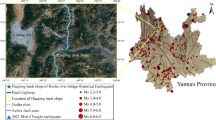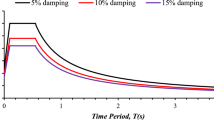Abstract
Underground structures are well known to be earthquake resistant. However, the recent earthquakes showed that underground structures are also vulnerable to seismic damage. There may be several reasons such as high ground motions and permanent ground movements. This study attempts to describe various forms of damage to underground structures such as tunnels, caverns, natural caves and abandoned mines during major earthquakes. Results of various model tests on shaking table are also presented to show the effect of ground shaking on the response and collapse of underground structures in continuum and discontinuum. Furthermore, some empirical equations are proposed to assess the damage to underground structures, which may be useful for quick assessments of possible damage.

























Similar content being viewed by others
References
Asakura T, Sato Y (1998) Mountain tunnels damage in the 1995 in Hyogo-ken Nanbu earthquake. 39(1), Railway Technical Research Institute (RTRI), p 9–16
Asakura T, Shiba Y, Sato Y, Iwatate T (1996) Mountain tunnels performance in 1995 Hyogo-ken Nanbu earthquake. Special report of the 1995 Hyogo-ken nanbu earthquake, Committee of Earthquake Engineering, JSCE
Aydan Ö (2003) Actual observations and numerical simulations of surface fault ruptures and their effects engineering structures. The eighth US–Japan workshop on earthquake resistant design of lifeline facilities and countermeasures against liquefaction. Technical report, MCEER-03-0003, 227–237
Aydan Ö (2007) Inference of seismic characteristics of possible earthquakes and liquefaction and landslide risks from active faults (in Turkish). The 6th national conference on earthquake engineering of Turkey, Istanbul 1:563–574
Aydan Ö, Genis M (2008a) Assessment of dynamic stability of an abandoned room and pillar underground lignite mine (in Turkish). Turkish J Rock Mech 16:23–44
Aydan Ö, Genis M (2008b) The seismic effects on the Bukit-Tinggi WWII underground shelter by 2007 Singkarak (Solok) earthquake. Proceedings of the ISRM international symposium 2008, fifth Asian rock mechanics symposium, Tehran, 917–924
Aydan Ö, Kawamoto T (2004) The damage to abandoned lignite mines caused by the 2003 Miyagi-Hokubu earthquake and some considerations on its causes. Third Asian rock mechanics symposium, Kyoto, 525–530
Aydan Ö, Shimizu Y, Karaca M (1994) The dynamic and static stability of shallow underground openings in jointed rock masses. The third international symposium on mine planning and equipment selection, Istanbul, October, 851–858
Aydan Ö, Ulusay R, Hasgür Z, Hamada M (1999) The behaviour of structures built in active fault zones in view of actual examples from the 1999 Kocaeli and Chi-chi Earthquakes. ITU-IAHS International Conference on the Kocaeli Earthquake 17 August 1999: a scientific assessment and recommendations for re-building, Istanbul, 131–142
Aydan Ö, Ulusay R, Kumsar H, Tuncay E (2000) Site investigation and engineering evaluation of the Düzce-Bolu earthquake of November 12, 1999. Turkish earthquake foundation, TDV/DR 09-51, p 220
Aydan Ö, Daido M, Ito T, Tano H, Kawamoto T (2006) Instability modes of abandoned lignite mines and the assessment of their stability in long-term and during earthquakes. Third Asian rock mechanics symposium, Singapore
Aydan Ö, Ohta Y, Hamada M (2009a) Geotechnical evaluation of slope and ground failures during the 8 October 2005 Muzaffarabad earthquake in Pakistan. J Seismol 13(3):399–413
Aydan Ö, Hamada M, Itoh J, Ohkubo K (2009b) Damage to civil engineering structures with an emphasis on rock slope failures and tunnel damage induced by the 2008 Wenchuan earthquake. J Disaster Res 4(2):153–164
Aydan Ö, Kumsar H, Toprak S, Barla G (2009c) Characteristics of 2009 l’Aquila earthquake with an emphasis on earthquake prediction and geotechnical damage. J Mar Sci Technol 9(3):23–51
Berberian M, Jackson JA, Qorashi M, Khatib MM, Priestley K, Talebian M, Ghafuri-Ashtiani M (1999) Ghafuri-Ashtiani M (1999) The 1997 May 10 Zirkuh (Qa’enat) earthquake (Mw.2): faulting along the Sistan suture zone of eastern Iran. Geophys J Int 136(3):671–694
Dowding CH, Rozen A (1978) Damage to rock tunnels from earthquake shaking. J Geoetech Engr Div, ASCE, GT2, 175–191
Esghi S, Zare M (2003) Bam (SE Iran) earthquake of 26 December 2003, Mw6.5: A preliminary reconnaissance report, http://www.iiees.ac.ir/
Genis M (2002) Investigation of the effects of geometrical design parameters on the dimensions of failure zone occurring around deep underground openings under static and dynamic conditions. Dissertation (in Turkish), Zonguldak Karaelmas University, Department of Mining Engineering, Zonguldak, Turkey, 352 p
Genis M, Aydan Ö (2002) Evaluation of dynamic response and stability of shallow underground openings in discontinuous rock masses using model tests. Korea-Japan joint symposium on rock engineering, Seoul, Korea, 787–794
Genis M, Aydan Ö (2007) Static and dynamic stability of a large underground opening. In: N. Bilgin et al. (eds) Proceedings of the second symposium on Underground excavations for Transportation (in Turkish), TMMOB, Istanbul, 138, 317–326
Genis M, Aydan Ö (2008) Assessment of dynamic response and stability of an abandoned room and pillar underground lignite mine. In: The 12th international conference of international association for computer methods and advances in geomechanics (IACMAG), Goa, India, 3899–3906
Genis M, Gerçek H (2003) A numerical study of seismic damage to deep underground openings. ISRM 2003-technology roadmap for rock mechanics, 10th ISRM congress, South African institute of mining and metallurgy, 351–355
Gerçek H, Genis M (1999) Effect of anisotropic in situ stresses on the stability of underground openings. In: Proceedings of the ninth international congress on rock mechanics, ISRM, Rotterdam, Balkema, vol 1, 367–370
Hashimoto S, Miwa K, Ohashi M, Fuse K (1999) Surface soil deformation and tunnel deformation caused by the September 3, 1998, Mid-North Iwate Earthquake. Seventh Tohoku regional convention, Jpn Soc Eng Geol
Japan society of civil engineers (1923) Archives of structural damage by the 1923 Great Kanto Earthquake. http://www.jsce.or.jp
Kanai K, Tanaka T (1951) Observations of earthquake motion at different depths of the earth. Bull Earthq Res Inst Tokyo Univ 28:107–113
Karaca M, Egger P, Aydan Ö, Sezaki M (1995) Mechanics of failure around shallow tunnels in jointed rock. In: Rossmanith (ed) Mechanics of jointed and faulted rock, Balkema, Rotterdam
Kawakami H (1984) Evaluation of deformation of tunnel structure due to Izu-Oshima Kinkai earthquake of 1978. Earthq Eng Struct Dyn 12(3):369–383
Komada H, Hayashi M (1980) Earthquake observation around the site of underground power station. CRIEPI report, E379003, Central Research Institute of Electric Power Industry, Japan, 1–34
Kuno H (1935) The geologic section along the Tanna Tunnel. Bull Earthq Res Inst 14:92–103
Nasu N (1931) Comparative studies of earthquake motions above ground and in a tunnel. Bull Earthq Res Inst 9:454–472
Okamoto S (1973) Introduction to earthquake engineering. University of Tokyo Press
Prentice C, Ponti D (1997) Coseismic deformation of the Wrights tunnel during the 1906 San Francisco earthquake: a key to understanding 1906 fault slip and 1989 surface ruptures in the southern Santa Cruz Mountains, California. J Geophys Res 102:635–648
Reilinger RE, Ergintav S, Burgmann R, McClusky S, Lenk O, Barka A, Gürkan O, Hearn L, Feigl KL, Çakmak R; Aktug B, Özener H, Toksöz MN (2000) Coseismic and postseismic fault slip for the 17 August 1999, M = 7.5, Izmit, Turkey Earthquake, Science, vol 289
Rozen A (1976) Response of rock tunnels to earthquake shaking. Dissertation in Civil Engineering. Massachusetts Institute of Technology
Sakurai T (1999) A report on the earthquake fault appearing in the Tanna tunnel under construction by North-Izu earthquake 1930 (in Japanese). J Japan Soc Eng Geol 39(6):540–544
Sharma S, Judd WR (1991) Underground opening damage to underground facilities. Eng Geol 30:263–276
TEC-JSCE (Tunnel Engineering Committee-JSCE) (2005) Report of the 2004 Mid Niigata Prefecture earthquake (in Japanese). JSCE
Tsuneishi Y, Ito T, Kano K (1978) Surface faulting associated with the 1978 Izu-Oshima- Kinkai earthquake. Bull of the Earthq Res Inst Tokyo Univ 53:649–674
Ueta K, Miyakoshi K, Inoue D (2001) Left-lateral deformation of head-race tunnel associated with the 2000 western Tottori earthquake. J Seismol Soc Jpn 54(2):547–556
Ulusay R, Aydan Ö, Hamada M (2002) The behavior of structures built on active fault zones: examples from the recent earthquakes of Turkey. Struct Eng Earthq Eng JSCE 19(2), special issue:149–167
Wang WL, Wang TT, Su JJ, Lin CH, Seng CR, Huang TH (2001) Assessment of damage in mountain tunnels due to the Taiwan Chi-Chi earthquake. Tunnel Undergr Space Technol 16:133–150
Whittaker BN, Reddish DJ (1989) Subsidence: occurrence, prediction and control. Dev Geotech Eng, 56, Elsevier, 528 p
Yashiro K, Kojima Y, Shimizu M (2007) Historical earthquake damage to tunnels in Japan and case studies of railways tunnels in the 2004 Niigata-ken Chuetsu earthquake. Q R RTRI 48(3):136–141
Acknowledgments
The authors would like to sincerely thank Emeritus Professor T. Kawamoto of Nagoya University for encouraging the authors to undertake these studies, Dr. H. Komada of Central Research Institute of Electric Power Companies (Japan) for providing information and data on underground powerhouses, Prof. Z. Hasgür of Istanbul Technical University, Prof. R. Ulusay of Hacettepe University, Prof. M. Hamada of Waseda University, Prof. K. Kawashima of Tokyo Institute of Technology, Prof. K. Konagai of Tokyo University, Prof. G. Barla of Politecnico di Torino for joining the authors during many site investigations of worldwide earthquakes since 1992 and former and current undergraduate and graduate students of Aydan’s laboratory in Tokai University for experimental studies in laboratory. The authors would also like to thank Prof. G. Barla for inviting them to contribute to the special issue on rock dynamics.
Author information
Authors and Affiliations
Corresponding author
Rights and permissions
About this article
Cite this article
Aydan, Ö., Ohta, Y., Geniş, M. et al. Response and Stability of Underground Structures in Rock Mass during Earthquakes. Rock Mech Rock Eng 43, 857–875 (2010). https://doi.org/10.1007/s00603-010-0105-6
Received:
Accepted:
Published:
Issue Date:
DOI: https://doi.org/10.1007/s00603-010-0105-6




